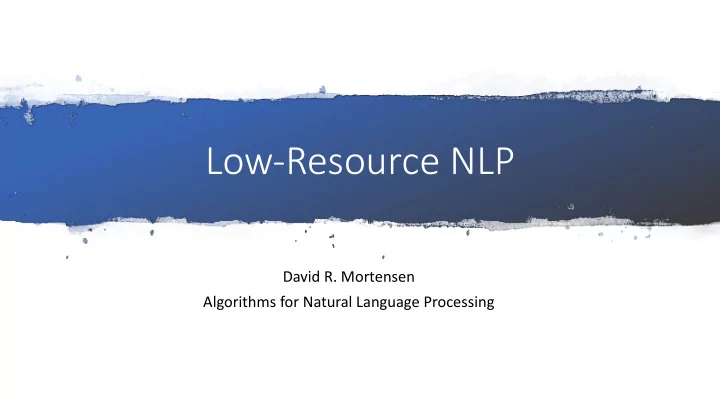

Low-Resource NLP David R. Mortensen Algorithms for Natural Language Processing
Learning Objectives • Know what a low-resource language or domain is • Know three main approaches to low-resource NLP: • Traditional/rule based • Unsupervised learning • Transfer learning • Know three examples of transfer learning
Low-Resource Natural Language Processing • Carrying out NLP tasks for… • languages… • domains… • without… • parallel corpora • extensive monolingual corpora • other annotated data • existing NLP tools
• Most languages are low-resource • Approximately 7,000 languages • Adequate NLP resources for about 10 languages Most NLP • Most people in the world speech a language not included in that 10 Problems are • Most domains are low-resource Low-Resource • Biomedical text NLP Problems • Legal text • Literary text • Twitter • Solving any of these problems requires doing low-resource NLP
Traditional • Get more data • Build language-specific tools with linguistic knowledge Unsupervised learning Approaches • Use machine learning techniques that do not require labeled training data Transfer • Exploit training data from higher-resource settings to provide supervision for low- resource scenarios
Traditional Approaches
• The naivest approach to low-resource scenarios is to convert them to high-resource scenarios • Obtain more unannotated data • Annotate it • This has a number of obvious shortcomings Obtaining • Raw data is often difficult to obtain. • Domains where only a limited amount More Data of text exists, like law or medicine • Languages that do not have a significant internet presence • Annotation of data is expensive • Turkers are cheap, but unskilled and still cost money • Experts are expensive and slow
Rule-Based NLP • One approach to low-resource NLP is to use models that are based on linguistic descriptions rather than being data-driven • Given a reference grammar of sufficient quality and a lexicon, a computational linguist can build rule-based models for many things: • Morphological analysis • Parsing • Named entity recognition • Relation extraction • However, this is also problematic • Not enough grammars • Not enough computational linguists
• However, using linguistic knowledge does not mean constructing an entirely rule-based system Linguistically • One successful approach: Inspired ≠ Rule • Combine linguistic knowledge and machine learning Based • Not easy with deep learning, but possible • For examples, stay tuned
Unsupervised Approaches
Not All Machine Learning is Supervised • Suppose you have a large body of unlabeled data, but little or no labeled data • You can extract a lot of patterns from it • For example, word embeddings and models like BERT are unsupervised • Human language learning is also largely unsupervised (although we do get some supervision for other senses) so we know it is possible to learn language without labeled data
Brown Clusters • Hierarchical agglomerative clustering of words based on the contexts in which they occur • Purely unsupervised • Semantically related words end up in the same part of the tree • City names cluster together • Country names cluster together • Colors cluster together • Example from SLP : suppose you want to know the probability of “to Shanghai” but the bigram “to Shanghai” never occurs in the data. You can estimate the probability by looking “to X” where X is other city names in the same cluster with Shanghai.
Transfer Learning
Learn One Place, Apply Elsewhere • As humans, we have little problem generalizing knowledge gained in one domain to other domains • When we are reading legal documents, we use knowledge that we gained reading everyday English • When we learn Japanese, we may use knowledge that we gained speaking Korean • This is the basic idea behind transfer learning • It involves techniques to “transfer” knowledge gained in one domain to another
One Example: Uyghur NER • Uyghur is a low-resource language spoken in the northwest of China. • It is related to other, higher-resource, languages like Uzbek, Kazakh, Turkmen, and Turkish • Turkish, Uzbek, and Uyghur are each written with a different script • We built a Uyghur NER model as follows: • Convert all of the data to IPA (the International Phonetic Alphabet) • Convert IPA to articulatory features (phonetic features that define how each sound is produced) • Train a model on Turkish and Uzbek • Tune the model on Uyghur, and test on Uyghur
Bharadwaj, A., Mortensen, D. R., Dyer, C., & Carbonell, J. G. (2016, November). Phonologically aware neural model for named entity recognition in low resource transfer settings. In Proceedings of the 2016 Conference on Empirical Methods in Natural Language Processing (pp. 1462-1472).
Another Example: Cross-Lingual Dependency Parsing • Interested parties have now produced a large collection of dependency treebanks called the Universal Dependency (or UD) Treebanks • Dependency trees have a lot in common between languages • This commonalities are often latent structures • Related languages tend to have more shared structural properties than randomly selected languages • It is possible to train cross-lingual or polyglot dependency parsers and to use them on languages for which there is no treebank • Lots of techniques for this
Recommend
More recommend